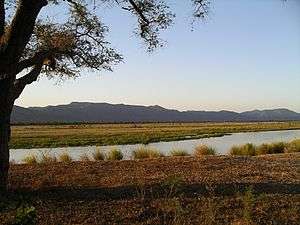Mana Pools
| Mana Pools National Park, Sapi and Chewore Safari Area | |
|---|---|
| Name as inscribed on the World Heritage List | |
 | |
| Type | Natural |
| Criteria | vii, ix, x |
| Reference | 302 |
| UNESCO region | Africa |
| Inscription history | |
| Inscription | 1984 (8th Session) |
| Designated | January 3, 2013 [1] |
Mana Pools is a wildlife conservation area in northern Zimbabwe constituting a National Park. It is a region of the lower Zambezi River in Zimbabwe where the flood plain turns into a broad expanse of lakes after each rainy season. As the lakes gradually dry up and recede, the region attracts many large animals in search of water, making it one of Africa's most renowned game-viewing regions.
Mana means ‘four’ in Shona, in reference to the four large permanent pools formed by the meanderings of the middle Zambezi. These 2,500 square kilometres of river frontage, islands, sandbanks and pools, flanked by forests of mahogany, wild figs, ebonies and baobabs, is one of the least developed National Parks in Southern Africa. It was saved from a hydro-electric scheme in the early eighties which would have seen the flooding of this subsequent World Heritage site. It has the country’s biggest concentration of hippopotamuses and crocodiles and large dry season mammal populations of elephant and buffalo. The Mana Pools were designated a Ramsar wetland of international importance on 3 January 2013.[2]
See also
- Chitake River
- Zambezi Escarpment
- Chewore Safari Area
- Sapi Safari Area
References
- ↑ "Ramsar List". Ramsar.org. Retrieved 14 April 2013.
- ↑ "The Annotated Ramsar List: Zimbabwe". The Ramsar Convention on Wetlands. Retrieved 20 February 2013.
External links
| Wikimedia Commons has media related to Mana Pools National Park. |
- Mana Pools - Zimbabwe Parks & Wildlife Authority
Gallery
-
Bridge on the Rukomechi River near Nyakasikana Gate, Mana Pools National Park
-
Zambezi River near Mutsango Lodge, Mana Pools National Park
-

Looking across the Zambezi River to the Zambezi Escarpment, Zambia, from Mana Pools National Park
-

Island in the Zambezi River from Mana Pools National Park
-
Rukomechi River from Nyakasikana Bridge, Mana Pools National Park
Coordinates: 15°45′S 29°20′E / 15.750°S 29.333°E
|